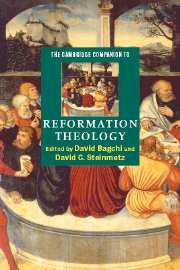Book contents
- Frontmatter
- Introduction
- 1 Late medieval theology
- 2 Lollardy
- 3 Hussite theology and the law of God
- 4 The theology of Erasmus
- 5 Luther
- 6 Melanchthon
- 7 Confessional Lutheran theology
- 8 The theology of Zwingli
- 9 Bucer
- 10 The theology of John Calvin
- 11 John Calvin and later Calvinism
- 12 The theology of Thomas Cranmer
- 13 The theology of the English reformers
- 14 The Scottish Reformation
- 15 An introduction to Anabaptist theology
- 16 Catholic theologians of the Reformation period before Trent
- 17 The Council of Trent
- Conclusion
- Select bibliography
- Index
- Series list
17 - The Council of Trent
Published online by Cambridge University Press: 28 May 2006
- Frontmatter
- Introduction
- 1 Late medieval theology
- 2 Lollardy
- 3 Hussite theology and the law of God
- 4 The theology of Erasmus
- 5 Luther
- 6 Melanchthon
- 7 Confessional Lutheran theology
- 8 The theology of Zwingli
- 9 Bucer
- 10 The theology of John Calvin
- 11 John Calvin and later Calvinism
- 12 The theology of Thomas Cranmer
- 13 The theology of the English reformers
- 14 The Scottish Reformation
- 15 An introduction to Anabaptist theology
- 16 Catholic theologians of the Reformation period before Trent
- 17 The Council of Trent
- Conclusion
- Select bibliography
- Index
- Series list
Summary
The general councils of the medieval Catholic Church were instruments for crisis management. This was particularly true in the early fifteenth century, when the church was divided by two, and then three, rival claimants to the papal throne. Unlike chapter meetings and episcopal visitations, councils were not a routine part of the church’s self-governance. When the Council of Trent finally convened in 1545, it was only the nineteenth general council in the long history of the Catholic Church.
The crises that provoked councils might be internal to the Catholic Church, such as the rise of the Joachite heresy, or stimulated by external pressures such as the Turkish invasion of Europe. They might touch on matters of the church’s doctrine or of its practice. Early councils articulated the dogmas of the Trinity and the two natures of Christ. Later councils decided on the place of icons in Christian worship, defined the doctrine of transubstantiation, and ended the scandal of a divided church.
Popes were often reluctant to take the risks inherent in the convocation of a general council. They were painfully aware that the Council of Constance had deposed three competing popes and installed a fourth. By the time of Luther, however, it was generally conceded, even by theologians who were jealous defenders of papal power, that under certain circumstances the convocation of a general council might be the church’s only recourse to resolve a crisis that had proved impossible to resolve in any other way.
- Type
- Chapter
- Information
- The Cambridge Companion to Reformation Theology , pp. 233 - 247Publisher: Cambridge University PressPrint publication year: 2004
- 4
- Cited by



